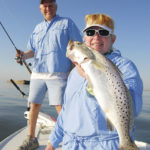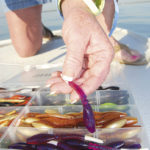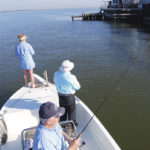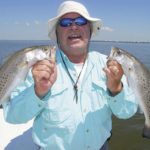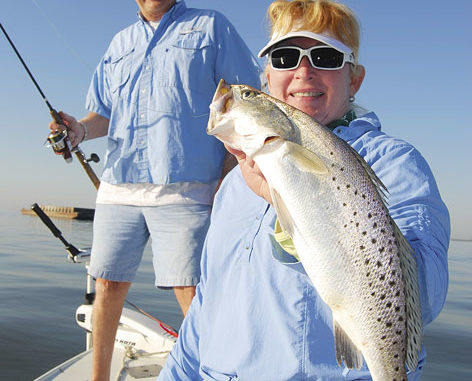
This is the month Calcasieu Lake anglers have been waiting for, when trout feast on the reefs and calm winds make them accessible.
Birds are about as reliable as the average Louisiana politician.
On the second-calmest day of the spring of 2011, Big Lake Guide Service’s Capt. Todd Jeffers motored north toward Turner’s Bay, and found non-stop action under flocks of dive-bombing gulls. He and his clients had their limits of fat Calcasieu speckled trout by 7:30 a.m.
On the very next day — the calmest day of the spring of 2011 — Mary Poe, Jeffers’ boss, assumed she’d be able to do the same.
With hints of morning light curling over the horizon behind her waterfront lodge, Poe (337-598-3268) pointed her bow north, lowered her throttle and looked out over a glass-slick Calcasieu Lake.
“We need the sun to get up just a little bit, so these birds can see the shrimp,” she said.
Big black-headed gulls were flying in haggard groups south to north, like businessmen late for a convention. They had obviously feasted in the northern part of the lake the day before, and didn’t want to miss out on this day’s party.
Poe and her clients bided their time at a reef near the Old Settlement, while the veteran guide scanned the horizon like a soldier on watch. Occasionally, she’d see a gull stop on a dime, wheel around and feint a dip. But invariably the birds would continue on their way, never amassing in the chaotic diving flocks that are like beacons for trout-loving Calcasieu anglers this time of year.
Poe was hoping the day would be all chicken salad, and instead, she got a hearty helping of chicken, um … you know.
Even still, she was about as bummed out as an Optimist Club president.
That’s because Poe, in her four decades of fishing the lake, has learned fishing Calcasieu this time of year is about as easy as falling off the proverbial log.
“May and June’s consistency is hard to beat,” she said. “The fish are everywhere in the lake, and it’s not hot enough yet to make them move somewhere else.”
So rather than sitting around all day waiting for the birds to cooperate, Poe motored to various reefs in the area, and put her clients on steady action throughout the morning.
During the month of June, Calcasieu Lake is on fire. The bait is plentiful, the trout are everywhere, and, most importantly, the weather is cooperative more times than not.
Jeff Poe, Mary’s husband, said fishing earlier in the spring is actually better, particularly for trophy trout, but only when the stars align and your fishing trip is on a calm day preceded by a calm day to allow the waters to settle and clean up. This year, of course, that happened absolutely never.
“But in June, everything settles down,” Poe said. “The water gets pretty and the fish are really active. It’s one of my favorite times of the year.”
Still, that doesn’t mean Poe ignores the conditions.
“The night before (the trip), I’ll definitely watch the weather so I’ll have a general idea of the wind speed and direction,” he said. “If it’s going to be blowing above 10 (m.p.h.), I know I need to fish the lee bank.”
With that in mind, Poe formulates a strategy for the day, pinpointing specific reefs he wants to fish and in which order so he can minimize his running time and maximize his fishing time.
He also pays close attention to the tidal forecast.
“If you’ve got an incoming tide and it’s strong, you want to stay away from the Ship Channel and away from the southern end of the lake,” he said, explaining that strong incoming tides dirty the water on the lower end of Calcasieu. “Everything from Nine-Mile Cut north will have decent water on an incoming tide.”
Poe said in the past, the Ship Channel was dredged to a depth of 35 to 40 feet. Now, however, it’s dredged to 45 feet, and that extra depth has caused a dramatic increase in the amount of water that flows through the channel. The additional water and resulting current dirties the surrounding areas much more than in the past.
Further muddying the water in the area are the shrimp trawlers that focus almost exclusively on the Ship Channel, Poe said.
On a falling tide, however, the water cleans up, and the veteran guide really shifts his attention to the southern end of the lake, particularly Nine-Mile Cut, the Washout and the Old Jetty.
“All of those are really great on a falling tide,” he said.
No matter where they intend to fish, however, the Poes always keep their eyes peeled en route for birds and slicks.
Jeff Poe particularly loves fishing slicks because of the information they often relay.
“You might run across a slick in the middle of the lake, and as you’re fishing it, you feel oysters (on the bottom),” he said. “You know there’s something there holding those fish.”
Poe will store such information in his GPS, and come back the next trip to see if those fish are still there. He’s found many of his favorite reefs that way.
To effectively fish slicks, Poe said it’s imperative to pay attention to which way the winds and tides are moving.
“Our tides here run north and south,” he said. “(The slick) will just sit there and grow if the wind is moving opposite of the tide.
“If the wind and tide are moving the same way, you’ve got to make sure you fish well upcurrent of the slick. If you see a series of slicks from small to large, you want to fish the small one.”
Poe said the best slicks typically are the ones he encounters when they’re about 4 feet in diameter. The small size means the fish have just begun to feed at that spot.
In fact, Poe won’t even stop for a large slick, unless he sees several big ones in an area, which is an indication that a large school may be on that spot.
No matter where they’re fishing, the Poes try to use all their senses to stay on the action.
“It’s a game of watching, listening and smelling,” Mary Poe said. “The average guy is out there drinking a beer, having a good time, waiting for the fish to bite.
“You’ve got to pay attention.”
Jeff agreed.
“The sound of a fish busting is magic,” he said. “You can hear it, but you can’t always see it. Sometimes it doesn’t even make a ripple.”
Poe equated the sound with a bream slurping a fly off the surface.
Calcasieu trout this time of year key on shrimp, mullet, pogies and even ribbonfish.
“This year, there are just a ton of pogies in the lake,” Jeff said.
The guides, of course, love seeing finger mullet, but even the big jumpers will give away trout location.
“If you find a reef with mullet on it — any size mullet — spend some time there,” Jeff advised.
When mullet are present, the Poes particularly like topwater baits, namely Super Spooks, She Dogs and SkitterWalks. They’re favorite colors are chrome/black, bone/chartreuse, clown and translucent chartreuse.
“The time of day doesn’t matter,” Jeff said. “Big fish like big baits any time of day.”
However, Poe isn’t one of those purists who’ll throw nothing but topwater plugs in hopes of catching the trophies.
“I wouldn’t be married to it,” he said. “We catch more big fish on soft-plastics than we do topwaters. Of course, we throw them a lot more. But it just goes to show you don’t need to be throwing a topwater to catch a big trout.”
As for soft-plastics, the Poes love Norton Sand Eels. Although the Sand Eel Jrs. certainly work, they prefer the full-size Sand Eels. The bigger baits are attractive to trophy trout, but they don’t seem to intimidate smaller fish.
They fish the soft-plastics almost exclusively on 1/4-ounce jigheads. Jeff said he starts his retrieve immediately after the bait hits the water. The retrieve, he said, is at a steady speed, but he twitches his rod tip to give the bait action.
“Sometimes I’m ripping it, but most of the time I’m reeling it in at a medium-slow speed,” he said.
Speed of the retrieve is vitally important, and the fish will change their preference from day to day. Also, anglers need to remember that different reels have different gear ratios.
“I’ve had clients on my boat put it on me while fishing a Zebco,” Jeff said with a chuckle. “It’s because the bait was moving so slow, and that’s what the fish wanted that day.”
Poe will vary the retrieval speed until he determines what the fish want. This causes his bait to track through all levels of the water column.
“I never let it touch bottom, but I know I’m close,” he said.
Mary agreed.
“I don’t know why, but if the bait keeps touching the bottom, it seems like they won’t hit it,” she said.
Their favorite soft-plastic colors are glow, opening night, avocado, chicken on a chain and black/chartreuse.
But what the heck? It’s June. Throw any color you want. The action is so good this month on Calcasieu that it probably won’t matter.
